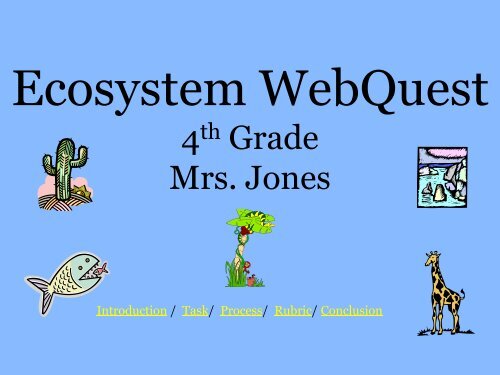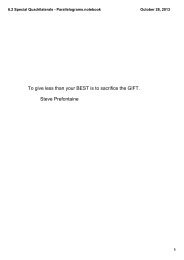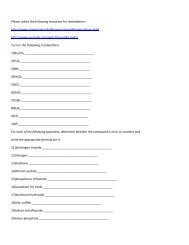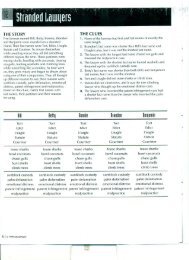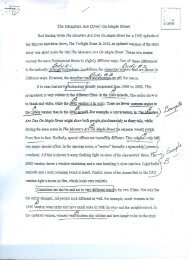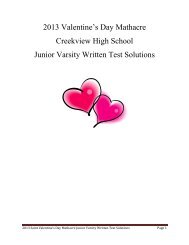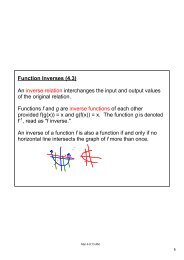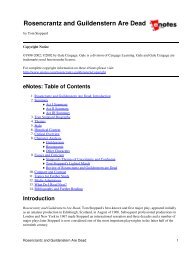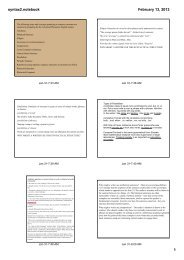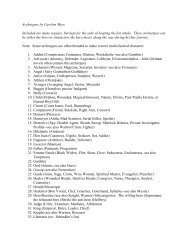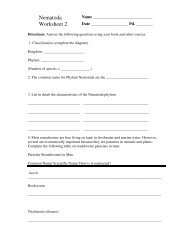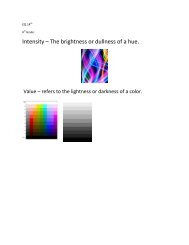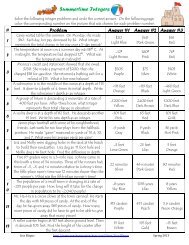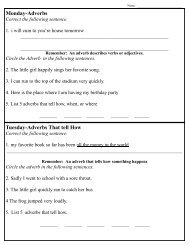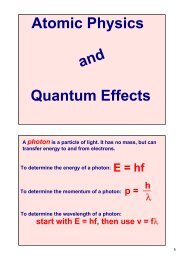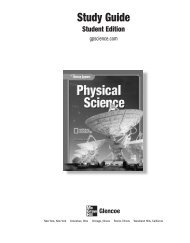Ecosystem Webquest.pdf
Ecosystem Webquest.pdf
Ecosystem Webquest.pdf
You also want an ePaper? Increase the reach of your titles
YUMPU automatically turns print PDFs into web optimized ePapers that Google loves.
<strong>Ecosystem</strong> WebQuest<br />
4 th Grade<br />
Mrs. Jones<br />
Introduction / Task/ Process/ Rubric/ Conclusion
We have just finished discussing the various<br />
ecosystems. You have learned just how complex this<br />
world can be. Our own environment is very diverse.<br />
We live in the Deciduous Forest where you can find<br />
things such as deciduous trees, fertile soil, chipmunks,<br />
squirrels, frogs, spiders, mosquitoes, etc. We also live<br />
in a environment that has warm and cold seasons. We<br />
have discussed how plants and animals survive in the<br />
desert and in the arctic. Through this WebQuest, we<br />
will look more in depth into the various ecosystems.<br />
Page 1
TASK<br />
Page 1<br />
You will be working in groups of 2-3 students<br />
researching an animal from a particular ecosystem.<br />
After you have chosen your animal you will then<br />
determine in which ecosystem it would best<br />
survive. In doing so you will learn a lot about your<br />
animal’s ecosystem and be able to answer the 5 Key<br />
Questions.<br />
5 Key Questions
THE PROCESS<br />
1. You will be assigned a group<br />
2. Each person in your group will have a role:<br />
1. Recorder Responsible for taking notes<br />
2. Tech. Support Responsible for computer<br />
3. Efficiency Expert Responsible for keeping group on task and complete the<br />
given assignments on time<br />
3. Each group will be given an animal from the list below:<br />
* Kinkajou<br />
* John Dory<br />
* Jerboa<br />
* Meerkat<br />
Page 1<br />
* Ermine
1. You will use the animal links to find out which<br />
ecosystem your animal best survives in.<br />
2. Once you have determined which one best fits your<br />
animal, you will need to research that ecosystem<br />
using the websites provided.<br />
3. As you research, make sure that you are answering<br />
the 5 Key Questions. The recorder should be<br />
writing down this information.<br />
4. Once you have answered the questions and<br />
recorded all of your answers, you will create a<br />
book about your ecosystem.
Animal Websites<br />
Kinkajou<br />
John Dory<br />
Jerboa<br />
Meerkat<br />
Ermine
<strong>Ecosystem</strong> Websites<br />
Click on an ecosystem that your animal<br />
comes from:<br />
Arctic<br />
Desert<br />
Grassland<br />
Coral Reef<br />
Tropical Rainforest
Other Websites:<br />
Biomes of the World<br />
<strong>Ecosystem</strong>s<br />
Biomes and <strong>Ecosystem</strong>s<br />
Biomes - Thinkquest<br />
Athropolis Arctic Library<br />
The Desert Biome<br />
What is a Prairie?<br />
Where are the Rainforests?<br />
World Map Biomes<br />
Blue Planet Biomes<br />
The Great Barrier Reef Experience
Assessment<br />
Click on the link below to view the grading guidelines for<br />
this project.<br />
Page 1<br />
Conclusion<br />
Assessment Rubric<br />
During this <strong>Ecosystem</strong> WebQuest students will have learned about the<br />
location of many different ecosystems and different plants, and animals that<br />
live there as well as the various climates. They will have completed several<br />
different tasks that will enable them to build cooperative learning skills and<br />
gain organizational, research, and presentation abilities
Cover Page<br />
•You will need to use the paper and ruler provided to you<br />
by your teacher.<br />
•You will need to set up your title page in landscape<br />
format<br />
•You will need to label your title page with your<br />
ecosystem name and the name of your group members.<br />
•You will need to outline your writing and make sure it is<br />
done neatly.
Page 1: Web<br />
• You will be using Kidspiration to create a web about<br />
your ecosystem.<br />
• The web will contain 4 components: Plants, Animals,<br />
Location, and Climate.<br />
• You will print out your web and add it to your book.<br />
• Click on the link below to see an example of what you<br />
will be creating.<br />
Sample Web
Page 2: Location<br />
• Using the information you have found on the web, you<br />
will be charting the location of your ecosystem.<br />
• You will be given an outline of a world map.<br />
• You follow the directions at the bottom of the map.<br />
• Be sure to read carefully and follow ALL of the<br />
directions.
Page 3: Climate<br />
You will be printing and filling in a climate chart that will<br />
have the following 3 categories:<br />
1. Precipitation<br />
2. Weather<br />
3. Temperature<br />
* In each of these categories you will provide the<br />
information about your ecosystem.
Page 4: Plants<br />
• You are going to use your previous research to find five<br />
plants that live in your ecosystem<br />
•You are going to have to draw each plant in detail and<br />
then carefully label and color each of them
Page 5: Animals<br />
• You are going to have to use your previous research to<br />
find eight other animals that live in your ecosystem.<br />
(You cannot use your own animal)<br />
•You are going to have to draw these eight animals in<br />
detail and then carefully label and color each of them.<br />
•You are going to have to find two animals from each of<br />
the following animal categories:<br />
Mammals<br />
Birds<br />
Insects<br />
Reptile/ Amphibians
Page 6: “Who Am I?” Poem<br />
• You are going to work together to create a “Who Am I?”<br />
poem. The other students in the class will try to guess<br />
your animal is based on your clues.<br />
•The format for the poem is the following:<br />
I am (name the color of your animal)<br />
I am (describe the size of your animal)<br />
I (describe how your animal moves. Ex: flies, slithers, runs<br />
I eat ( name what your animal likes to eat)<br />
I am special because (tell an interesting fact about your animal<br />
I am a type of (name a classification Ex: bird, mammal, amphibian)<br />
I like to (describe something special your animal does)<br />
I live in the (where does your animal live)
Page 7: Animal Picture<br />
• Draw a detailed illustration of your animal (you<br />
cannot trace your animal) on the paper provided.<br />
• You must color your illustration neatly.<br />
• The background of your illustration must represent the<br />
ecosystem that your animal lives in.<br />
• Do not leave any white space on your illustration.<br />
•Your illustration must be and all pencil marks must be<br />
erased.
Page 8: Venn Diagram<br />
• You will be printing out and completing a Venn diagram<br />
•You will compare and contrast your ecosystem to the<br />
deciduous forest ecosystem.<br />
•Be sure to find as many similarities and differences<br />
between the two ecosystems as you can.
Page 9: Your Free Page!<br />
• On this final page you will be able to add any other<br />
interesting information that you have not already<br />
included in your book.<br />
• Put all of your pages in the correct order.<br />
• Use the construction paper provided to create a book<br />
jacket for your book.<br />
•Illustrate your book jacket. Be sure to include the title<br />
•Be creative and have fun!
5 Key Questions<br />
1) What ecosystem does your animal live in?<br />
2) Where is this ecosystem located?<br />
3) What kinds of plants (flora) live there?<br />
4) What kinds of animals (fauna) live there?<br />
5) What is the climate like?<br />
Back to <strong>Webquest</strong>
Use Kidspiration 3 to create a web of your ecosystem. Use this sample<br />
web as a guide.<br />
Back to <strong>Webquest</strong>
Back to <strong>Webquest</strong><br />
Neatly label the 7 continents and 4 major oceans. Lightly pencil in the location of<br />
your ecosystem. Color the land in green and the water in blue. Choose a third color<br />
to shade in your ecosystem location. Create a map key showing the colors you used.
Climate of your <strong>Ecosystem</strong><br />
Precipitation<br />
Temperature<br />
Weather<br />
Back to <strong>Webquest</strong>
Names ______________________<br />
Back to <strong>Webquest</strong><br />
Directions: Use this Venn diagram to compare and contrast the<br />
deciduous forest to your animals ecosystem.<br />
___________________ Deciduous Forest
3 2 1<br />
Team Work Group worked well together all of Group worked well together<br />
the time<br />
most of the time<br />
5 Key Questions All 5 Key Questions were 3-4 Key Questions were<br />
answered correctly<br />
answered correctly<br />
Cover Page Cover Page includes all of the<br />
required elements and is neat<br />
Page 1- <strong>Ecosystem</strong> Web Web includes all 4 components<br />
and details for each<br />
Page 2 –<br />
World Map<br />
Page 3-<br />
Climate<br />
Page 4 –<br />
Plants<br />
Page 5-<br />
Animals<br />
Page 6 –<br />
Poem<br />
Page 7 –<br />
Animal Picture<br />
Page 8 –<br />
Venn Diagram<br />
Page 9 –<br />
Free Page<br />
Cover Page includes all of the<br />
required elements but is not<br />
neat<br />
Web includes only 3<br />
components and details for<br />
each<br />
Group did not work well<br />
together<br />
1-2 Key Questions were<br />
answered correctly<br />
Cover Page is missing 2 or<br />
more elements<br />
Web includes 2 or fewer<br />
components and/or missing<br />
details<br />
All components are included 1-2 components are missing 3 or more components are<br />
missing<br />
All components are included and 1-2 components are missing 3 or more components are<br />
accurate<br />
missing<br />
5 plants are included neatly 3-4 plants are included neatly 1-2 plants are included neatly<br />
5 animals are included neatly 3-4animals are included neatly 1-2animals are included neatly<br />
The poem follows the format and<br />
makes sense.<br />
The illustration is neat, and the<br />
background represent the<br />
animal’s habitat.<br />
5 or more similarities and<br />
differences are used.<br />
New information is included<br />
neatly.<br />
Book Jacket The book jacket is neat. It<br />
contains a title, illustration, and<br />
the names of the group members.<br />
<strong>Ecosystem</strong> Rubric<br />
The poem makes sense, but<br />
does not follow the format.<br />
The illustration represents the<br />
animal’s habitat, but it is not<br />
neat<br />
3-4 similarities and differences<br />
are used.<br />
The information is neat, but<br />
was already used in the book.<br />
The book jacket contains all of<br />
the elements, but is not neat.<br />
Back to <strong>Webquest</strong><br />
The poem does not follow the<br />
format, and does not make<br />
sense.<br />
The illustration is not neat,<br />
and the background does not<br />
represent the animal’s habitat.<br />
1-2 similarities and<br />
differences are used.<br />
No information was included.<br />
The book jacket is not neat,<br />
and is missing some or all of<br />
the elements.


